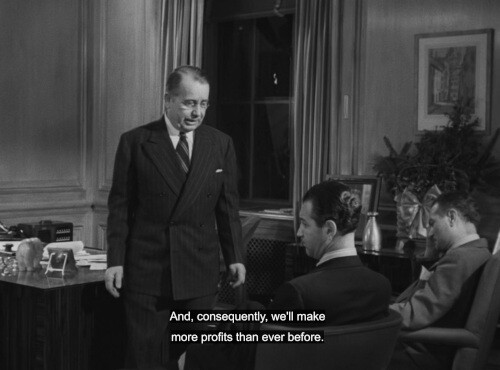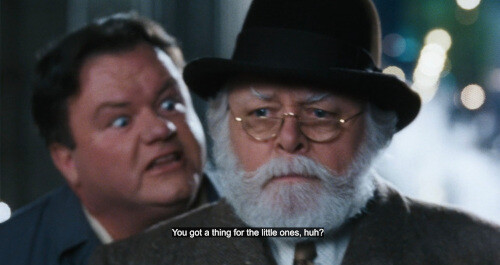‘Miracle on 34th Street’: The Anti-Capitalist Satire Hiding Inside A Family Classic

Back in the days when movies about Santa Claus didn’t routinely feature ancient sex contracts or castrating elf monsters, we got Miracle on 34th Street, the classic story about how a man calling himself “Kris Kringle” lands a job as a department store Santa … but ends up getting thrown into a mental health facility, and is only sprung on Christmas Eve thanks to a razor-thin legal technicality. Happy Holidays.
Miracle on 34th Street is generally regarded as one of the warmest, sweetest, least-threatening family Christmas movies of all time – but there’s another layer to the 1947 film that isn’t as widely acknowledged these days; it’s a pretty cutting satire, ruthlessly lampooning the hollow machinations of adult society.
Obviously, the movie is overtly about Kris attempting to work against the consumerist forces that have corrupted Christmas. And while this struggle is manifested in his relationship with the characters of Doris and Susan, the skeptical store manager, and her daughter, the rest of the world is routinely exposed for its ineptitude and laughable dysfunction.
Don't Miss
Kris Kringle is fundamentally good – but most of the people around him only help the old codger purely out of self-interest. When he starts sending customers to department stores other than Macy’s, the company adopts his goodwill as an official store policy purely in order to “make more profits than ever before.” Yup, even Kris’ efforts to de-commercialize Christmas are themselves commercialized.

20th Century Studios

20th Century Studios
Really, only a handful of adult characters help Kris out due to the goodness of their hearts – Christmas is saved in the end, mostly thanks to corporate avarice, sweaty political aspirations, and good old-fashioned bureaucratic incompetence.
For example, Kris is kept on at Macy’s, not because anyone suspects he’s the real Santa, but purely because he’s good for business. And when he’s arrested and tried for “lunacy,” the court actually acknowledges the existence of Santa Claus as a magical being – but this is the direct result of advice given by the judge’s fast-talking political adviser, who warns him about the dangers of pissing off voters who rely on the image of Santa to sell loads of junk every December.

20th Century Studios

20th Century Studios
The movie’s biting contempt for the upper classes of society is also briefly tossed off in a line about how Kris is only as delusional as “some of those men in Washington” or, although he’s unnamed in the film, Hollywood restaurateur Michael Romanoff. We root for Kris Kringle, not just because he might be Santa, but because his absurd belief is no more absurd than any of the other systemic conventions people regularly cling to – the only difference is that his delusion isn’t motivated by self-interest and avarice.
Even the touching ending, in which Kris is saved after the court receives bags and bags of letters to Santa, points to this theme. Sure, it happens as the direct result of Susan believing in him for the first time, but the decision is made by two shifty postal workers purely looking to make their lives easier by making troublesome bags of dead letters into someone else’s damn problem.
It’s also important to view Miracle on 34th Street within its historical context. Coming just two years after the end of World War II, the film is arguably a “feminist classic,” with Doris’ role as a smart, powerful career woman never questioned or undermined – not to mention that she’s a single mother and divorcee, which is why the film was decried as being “morally offensive” by the Catholic Legion of Decency upon its release. And there’s an important satirical element that’s easy to miss today; the film’s antagonist is Dr. Sawyer, Macy’s resident psychologist, who is himself an unhappy, cartoonishly neurotic square.

20th Century Studios
In 1947, this was a very specific reference, not an attack on the field of psychology as a whole, but specifically on the prevalence of “personality tests” in the workplace. Originally created during World War I, these quick psychological tests were intended to detect PTSD, then referred to as “shell shock,” but the tests eventually “filtered into the workplace” and became “firmly institutionalized in factories and large companies” by the end of World War II.
The fact that the comically incompetent Sawyer, with his quickie psych examinations, is ostensibly the film’s villain seems to be another key ingredient in the film’s anti-capitalist satire; when said tests were adopted by businesses following World War I, they weren’t simply used by employers to better workers’ mental health, but rather, to “stave off labor unrest” by arguing that “that people who advocated for labor unions were people who were unsettled and neurotic themselves.”
It’s also worth noting that most of these thematic building blocks were totally abandoned in the 1994 remake. The Sawyer character is dropped, which makes sense, but he’s replaced by a bitter ex-Santa who was fired for drunkenness and replaced with Kris. And he’s now working with the evil rival department store and accusing Kris Kringle of pedophilia in this family movie for some baffling reason.

20th Century Studios
Gone is the supposition that the consumer circus is inane and harmful, and instead, we have the pro-consumerist message that some stores are good, some are bad, and corporate competition is ultimately for the best if the good business wins.
Even the classic ending is radically changed – instead of the mailbag thing, Kris Kringle is saved by both God and the power of U.S. currency since “In God We Trust” is branded on money; therefore, Santa must be cool. Which is, one could argue, a slap in the face to the humanist themes and the economic critiques of the original.
And while the original has subsequently earned praise for being progressive, as seen in its final scenes, in which Doris falls in love with Fred, and they all stumble upon Susan’s dream house, but pointedly “don’t set up marriage plans or talk of building a life with more children as one would expect in a 1947 film.”
Somehow, the story became far more conservative in the ‘90s; Susan’s Christmas wish for a family leads the Doris character and her love interest to immediately get married, and even seemingly impregnated, on Christmas Eve. Because as we all know, Santa Claus has magical, sperm-controlling superpowers.
As further evidence that modern society hasn’t truly heeded the lessons of Miracle on 34th Street, in 2012, the real Macy’s released a commercial in which Kris Kringle has been digitally copied and pasted into new footage featuring celebrities such as Justin Bieber, Taylor Swift and … oh dear, God, no.

YouTube

YouTube
You (yes, you) should follow JM on Twitter (if it still exists by the time you’re reading this).
